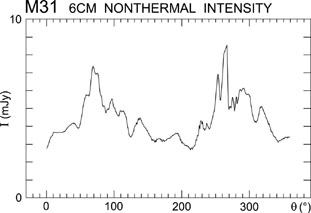


Radio continuum emission tells us about the distribution of
magnetic fields and cosmic rays. Figure 1 shows
the total and polarized intensities of M31 at
 6 cm. The "ring" at about
10 kpc radius is well defined in both components. In total emission the
similarity to the ring of CO emission (Nieten et al., this volume)
and dust emission (Haas, this volume) is
striking and gives further evidence that magnetic fields are anchored
in gas clouds
(Berkhuijsen et al., 1993).
6 cm. The "ring" at about
10 kpc radius is well defined in both components. In total emission the
similarity to the ring of CO emission (Nieten et al., this volume)
and dust emission (Haas, this volume) is
striking and gives further evidence that magnetic fields are anchored
in gas clouds
(Berkhuijsen et al., 1993).
 |
Figure 1. Total intensity of M31 at
|
The general coincidence of total and polarized emission regions in the ring is unusual. In all other spiral galaxies observed so far, polarized intensity is strongest between the spiral arms as traced by total emission, but weak in the arms due to field tangling by star-formation activity (Beck et al., 1996). Star formation activity is probably too weak to tangle M31's regular field significantly.
The variations of total nonthermal intensity (corrected for thermal emission) and polarized intensity with azimuthal angle (Fig. 2) reveal peaks near the minor axis and minima near the major axis, while the unpolarized nonthermal intensity shows almost no azimuthal variation. In polarized intensity, the peaks are roughly symmetric and the minima are deep, as expected from polarized emission from a strongly inclined toroidal field. Polarized synchrotron emission traces the component of the regular field perpendicular to the line of sight which is largest near the minor axis and smallest near the major axis of the galaxy's projected disk. Total synchrotron emission also depends on irregular fields which lead to unpolarized emission filling the minima of polarized emission near the major axis.
Polarized intensity varies as:
 |
where NCRE is the number density of cosmic-ray
electrons in the relevant energy range,
 nt is the
nonthermal spectral
index and
nt is the
nonthermal spectral
index and  is
the viewing angle between the field and the line of
sight. In case of equipartition between cosmic rays and magnetic fields,
NCRE
is
the viewing angle between the field and the line of
sight. In case of equipartition between cosmic rays and magnetic fields,
NCRE  Btot2.
Btot2.
For an axisymmetric spiral field with a pitch angle p:
 |
where  is the
azimuthal angle in the plane of the galaxy
and i is the galaxy's inclination. For M31,
is the
azimuthal angle in the plane of the galaxy
and i is the galaxy's inclination. For M31,
 nt
nt
 -1 (see above),
p
-1 (see above),
p  -12°
(Fletcher et al., this volume) and
i
-12°
(Fletcher et al., this volume) and
i  78°.
78°.
The variation of ln Ip with
ln | sin | was
computed between 8 and 12 kpc radius
1.
In three quadrants the slopes are around 2, a flatter slope
of 1.3 was found only in the NW quadrant. The slope
of
| was
computed between 8 and 12 kpc radius
1.
In three quadrants the slopes are around 2, a flatter slope
of 1.3 was found only in the NW quadrant. The slope
of  2 means that the
variation of Ip can be described by the
variation in
2 means that the
variation of Ip can be described by the
variation in  due to geometry while NCRE and Breg
are roughly constant along the ring. Locally in the ring, the nonthermal
degree of polarization increases to
due to geometry while NCRE and Breg
are roughly constant along the ring. Locally in the ring, the nonthermal
degree of polarization increases to
 50%.
The magnetic field of M31 is exceptionally regular.
50%.
The magnetic field of M31 is exceptionally regular.
 |
 |
Figure 2. Variation of nonthermal intensity
(a) and polarized intensity (b) at
|
1 based on the "old" distance of 690 kpc, for better comparison with previous results. Back.